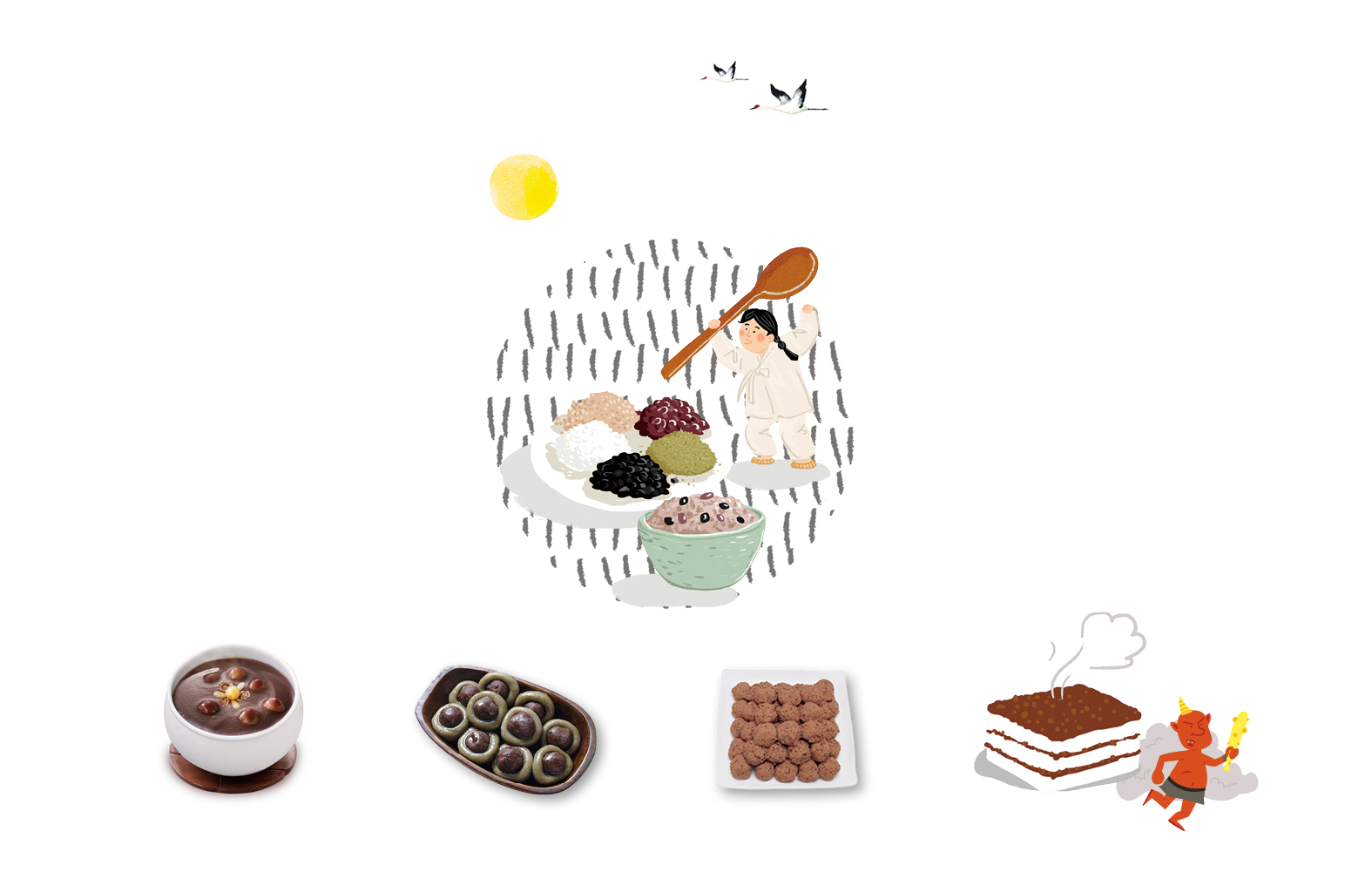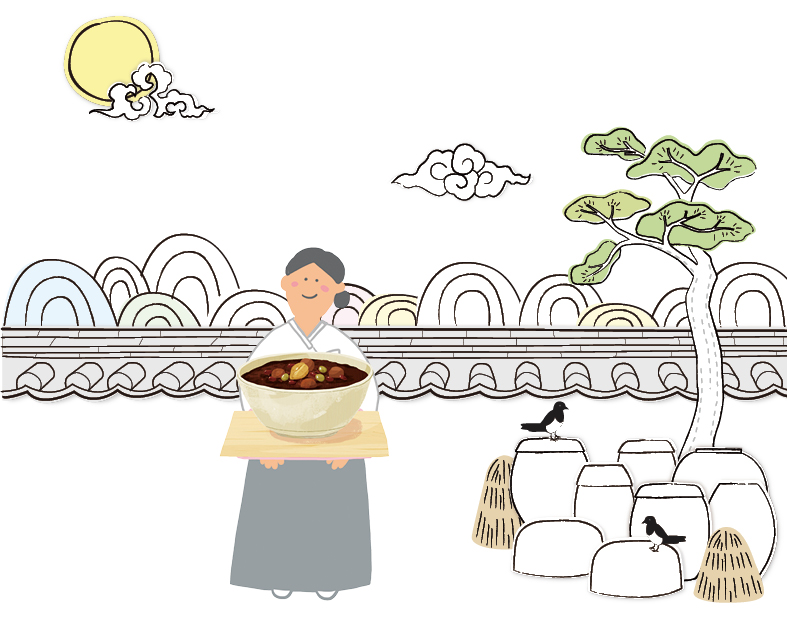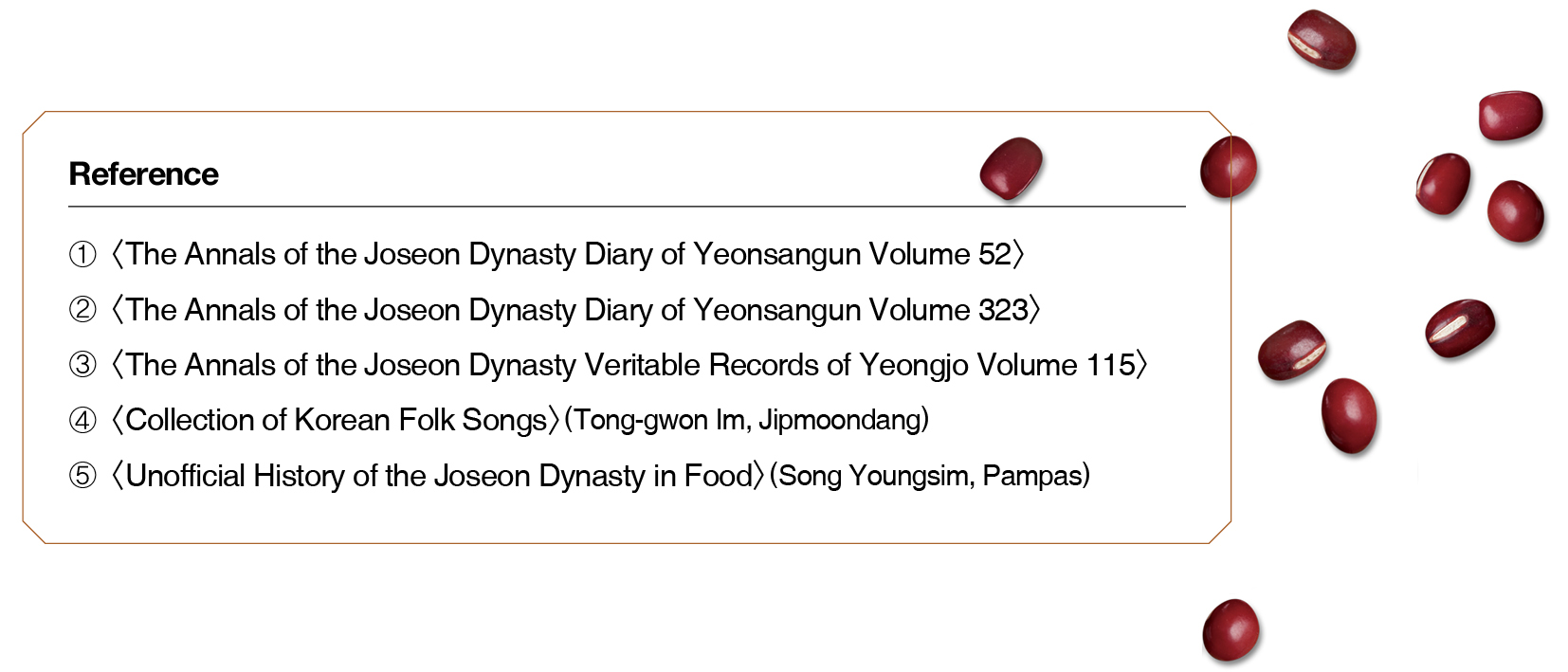한식 읽기 좋은 날
Vol 46. Rediscovery of Pat
Pat Through the Humanities
Pat has been an important crop for our people in Korea for a long time to the extent that it was excavated from the Bronze Age ruins. Let’s take a look at the story of pat that had been intertwined with our history for a long time.
Article. Jung Younghye(History Columnist)

Pat that has been with us for many years
Pat(red bean) has been cultivated in Korea for a long period of time. The origin of pat
is East Asia, where it was cultivated in China, Korea, and Japan before spreading to the American continent, Australia, New Zealand, and Africa via Hawaii.
In Korea, the first carbonized red beans were excavated from the Bronze Age ruins in Odong, Hoeryeong-gun, and Hamgyeongbuk-do. In addition, an earthenware with red bean shapes was excavated in the submerged area of Paldang, Yangpyeong. Later, red beans and mung beans were also excavated from the military warehouse site of Baekje, and during the Joseon Dynasty, red beans were included in the tax item and used as a gift to those who made great achievements or the royal family members. Moreover, <Gyuhap Chongseo(閨閤叢書)> and <Jeongjoji(鼎俎志)>, the encyclopedias from the late Joseon Dynasty, recorded that red beans were added when making five-grain rice on the 15th day of the New Year.
The red bean is an important crop that has been with our people for a long time. Our ancestors believed that the reddish color of the red beans had the power to ward off evil spirits, so the recipes using red beans were further developed. The representative dishes using red beans include patbap(red bean rice), patjuk(red bean porridge), pattteok(sirutteok: red bean steamed rice cake), patgomul(red bean filling), patdanja(red bean rice cake), patpyeon(type of red bean rice cake), pat gochujang(red chili paste made with red beans), patipguk(red bean leaves soup), etc. The most popular among these are sirutteok and patjuk.
Sirutteok, which was called jeungbyeong(甑餠), was used for ancestral rites. It was made by transforming glutinous rice or non-glutinous rice into powder, and making layers with the rice cake and red bean fillings repeatedly. At this time, radishes were also added and steamed, and such rice cake was called musirutteok(radish and red bean steamed rice cake) or nabokbyeong(羅蔔餠). This musirutteok appears in Tteoktaryeong(rice cake ballad), a traditional folk song, as a rice cake eaten in October of the lunar calendar.
Red beans were added when making sirutteok in order to avoid disaster by using red beans that evil spirits were afraid of. Our ancestors believed that ghosts had the nature of yin. Thus, it was believed that when the yin met the yang, the polar opposite of yin, and fire, the most powerful yang, the ghost would flee in terror. Since red is the color that symbolizes fire, red beans were also thought to be capable of warding off ghosts.
Becoming part of our customs
After the harvest in October of the lunar calendar, our ancestors held a rite by preparing sirutteok, fresh fruits, and liquor. Among many rites, the one called “Antaek(安宅),” which prayed for the family’s well-being and happiness to the household deities, was considered as the most important. The representative household gods are Sungjusin, the highest household god that was in charge of all household affairs; Teoujusin, the household god that can be found on a jangdokdae(a platform for crocks of sauces and condiments) that protected the house site and gave financial fortune; and Jowangsin, the household god that can be found in a bootoomak(wood-burning stove in the kitchen) that managed the kitchen. In addition, for Chilsungsin, Chuksin, Madangsin, Munsin, Samsinhalmeoni, etc., no separate rites were held for them, but only offerings were placed.
This custom is well-documented in the <Dongguk Sesigi(東國歲時記: Record of the Seasonal Customs of Korea)> written by Hong Sok-mo, a scholar during the reign of King Heonjong of the Joseon Dynasty. According to the book, “In our custom, on the first horse day(午日) of the new year, a rite called jeungbyeongdosin(甑餠禱神: praying to deities with sirruteok) was held by making patsirutteok(red bean steamed rice cake) and praying for musataean(無事泰安: safety and well-being) throughout the year. At this time, patsirutteok was made with many thick layers of rice cake and red beans, and boiled pig’s head, dried pollack, and freshly drawn water were placed in specific places.” The sirutteok used for the rite was said to be made with sincerity. They made sure to use freshly harvested rice and red beans. They also woke up at dawn when the stars were shining, and carefully steamed the rice cakes. People purified themselves by taking a bath prior to the rite and proceeded carefully to avoid bad luck. It was because they feared that if they suffer from bad luck, the rice cake would not be cooked properly. Our ancestors also made sirutteok at deungsinje, a rite of wishing for a good harvest, when they moved, or started a new business, and when they received ham(a box of wedding gifts sent by the bridegroom to his bride before the wedding) to block any bad luck and pray for the people’s well-being and good fortune.
Dongji patjuk, like sirutteok, was also a representative dish made and eaten to ward off ghosts and block bad luck. Dongji(winter solstice) is the 22nd term of the 24 solar terms, and it is the day with the longest night of the year. Our ancestors saw winter solstice as the day the sun was reborn. Therefore, Dongji was regarded as a little new year. The saying, “You get a year older after you eat patjuk on winter solstice,” was based on this perception.
People eat patjuk with saealsim(small glutinous rice balls) together with tteokguk(rice cake soup) on New Year’s Day. They believe that they will get older only after eating patjuk with saealsim added as many as their age. The custom of using red bean porridge to drive away evil spirits originated in China. According to the Hyungcho Sesigi(荊楚歲時記), which records the seasonal customs of the Hyuncho(Jingchu) region during the North and South Dynasties in China, Gonggong had a son who had no talent. It is also said that the son died on winter solstice and became a ghost that spread epidemic. Since this ghost was afraid of red beans, the custom of making red bean porridge on winter solstice was born to defeat it. The origin of red bean porridge is also cited in Hong Sok-mo's <Dongguk Sesigi> as mentioned earlier. Moreover, Yi Saek’s <Mokeunjip(牧隱集: The Collected Works of Mogeun)> of the Goryeo period and Yi Jehyeon’s <Ikjaejip(益齋集: The Collected Works of Ikjae)> contain a poem about eating red bean porridge on winter solstice. Therefore, it can be inferred that the custom of eating red bean porridge on winter solstice was already popular in the Goryeo Dynasty.

Wishing for good fortune with pat
Our ancestors, who believed that patjuk would drive away evil spirits, made patjuk on winter solstice, placed it in shrines and throughout the house, and sometimes sprinkled it on walls and door panels. Similar to sirutteok, this was used to ward off evil and pray for the well-being and happiness of the family. Dongji is called slightly different depending on the time of year. If it is placed early in the month it is called Aedongji(兒冬至), Jungdongji(中冬至) in the middle of the month, and Nodongji(老冬至) at the end of the month. Patjuk is made for Jungdongji and Nodongji, but not for Aedongji. It is because our ancestors believed that if patjuk was made on Aedongji, bad fortune would befall the children of the family. Therefore, people ate sirutteok instead of patjuk on Aedongji. King Yeongjo of the Joseon Dynasty, who was famous for being frugal, criticized the statement: “Even if the red bean porridge served on winter solstice is meant to revive the yang energy, it is a waste to sprinkle it, so it is important to correct such bad customs.” However, the custom of eating red bean porridge itself was not prohibited, and it is said that on winter solstice day, King Yeongjo called together the beggars on Jongno Street on his way back from his mother’s grave and fed them with patjuk. However, despite the royal command, the custom of eating patjuk on winter solstice persisted. It is said that, in addition to winter solstice, patjuk was made and sprinkled on the road to ward off disease in some regions when an epidemic hit. Moreover, it is said that patjuk was fed to the chief mourner who was weakened during a funeral process, and to a person who was in recovery from a long illness. When people moved or built a new house, they made patjuk and sprinkled it in the corners of the house or jangdokdae. The reason why this custom of eating patjuk has continued for a long time is probably because our ancestors' warm hearts for family happiness and peace were intertwined with it. Nowadays, when everyone is suffering from the pandemic, how about making warm patjuk and sharing it with your family by following the heart of our ancestors who wished for a healthy and safe new year?




